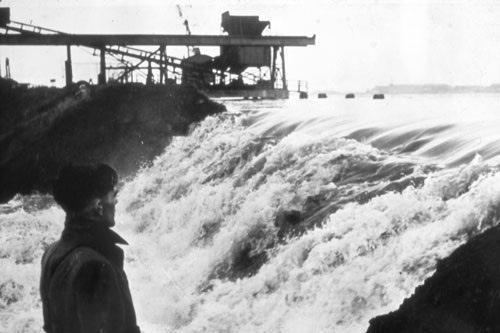 | ||
Date 31 January – 1 February 1953 Deaths Property damage 9% of total Dutch farmland flooded, 30,000 animals drowned, 47,300 buildings damaged of which 10,000 destroyed Similar | ||
Rotterdam the 1953 north sea flood disaster
The 1953 North Sea flood (Dutch: Watersnoodramp, literally "water emergency disaster") was a major flood caused by a heavy storm that occurred on the night of Saturday, 31 January 1953 and morning of Sunday, 1 February 1953. The floods struck the Netherlands, Belgium, England and Scotland.
Contents
- Rotterdam the 1953 north sea flood disaster
- North sea flood of 1953 60 years on
- Netherlands
- Warnings
- Resulting damage
- Near flooding of other parts
- Reaction
- United Kingdom
- Belgium
- Responses
- Commemoration
- Books films and music
- References
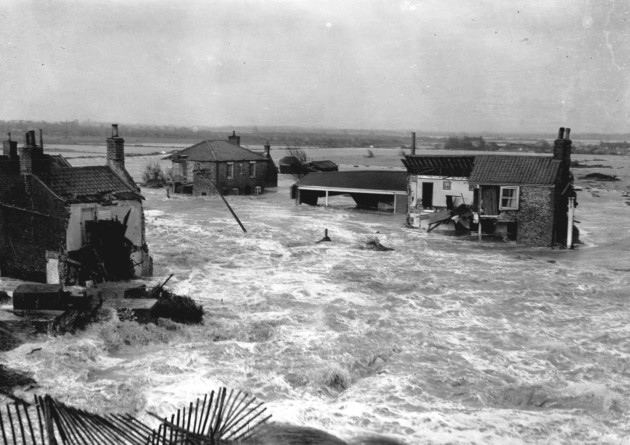
A combination of a high spring tide and a severe European windstorm over the North Sea caused a storm tide; the combination of wind, high tide, and low pressure led to a water level of more than 5.6 metres (18.4 ft) above mean sea level in some locations. The flood and waves overwhelmed sea defences and caused extensive flooding. The Netherlands, a country with 20% of its territory below mean sea level and 50% less than 1 metre (3.3 ft) above sea level and which relies heavily on sea defences, was worst affected, recording 1,836 deaths and widespread property damage. Most of the casualties occurred in the southern province of Zeeland. In England, 307 people were killed in the counties of Lincolnshire, Norfolk, Suffolk and Essex. Nineteen were killed in Scotland. Twenty-eight people were killed in West Flanders, Belgium.
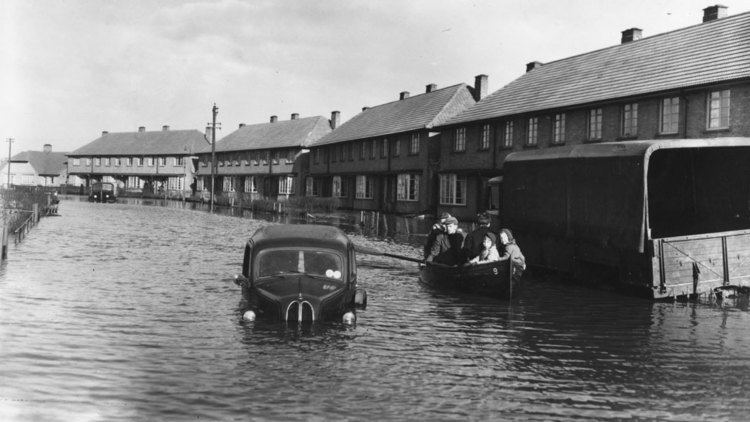
In addition, more than 230 deaths occurred on water craft along Northern European coasts as well as on ships in deeper waters of the North Sea. The ferry MV Princess Victoria was lost at sea in the North Channel east of Belfast with 133 fatalities, and many fishing trawlers sank.
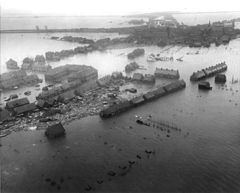
Realising that such infrequent events could recur, the Netherlands particularly, and the United Kingdom carried out major studies on strengthening of coastal defences. The Netherlands developed the Delta Works, an extensive system of dams and storm surge barriers. The UK constructed storm surge barriers on the River Thames below London and on the River Hull where it meets the Humber estuary.
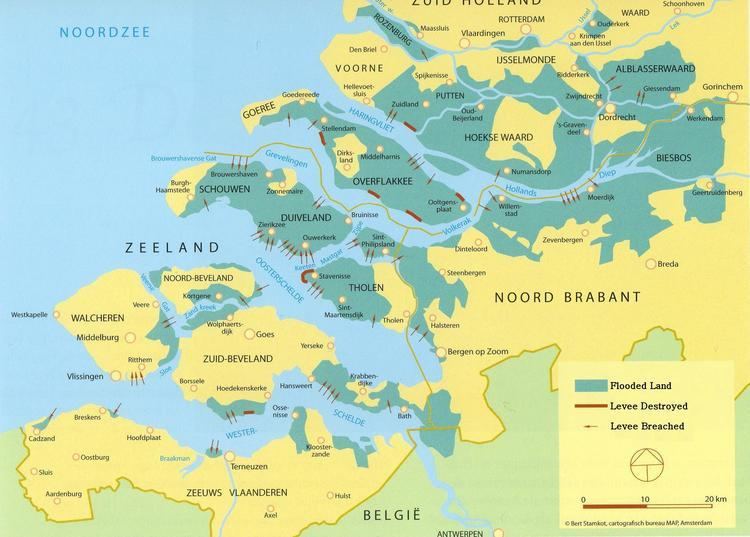
North sea flood of 1953 60 years on
Netherlands
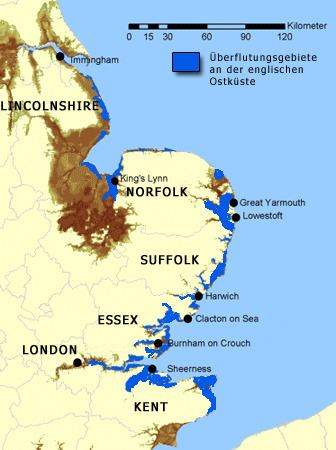
On the night of 31 January – 1 February 1953, many dykes in the provinces of Zeeland, South Holland and North Brabant proved unable to resist the combination of spring tide and a northwesterly storm. On both the islands and the mainland, large areas of country were flooded. Many people still commemorate the dead on 1 February.
Warnings
At the time of the flood, none of the local radio stations broadcast at night, and many of the smaller weather stations operated only during the day. As a result, the warnings of the KNMI (Royal Netherlands Meteorological Institute) did not penetrate the flood-threatened area in time. People were unable to prepare for the impending flood. As the disaster struck on a Saturday night, many government and emergency offices in the affected area were not staffed.
As telephone and telegraph networks were disrupted by flood damage, within hours amateur radio operators went into the affected areas with their equipment to form a voluntary emergency radio network. These well-organized radio amateurs worked tirelessly, providing radio communications for ten days and nights, and were the only people able to maintain contact from affected areas with the outside world.
Resulting damage
Large parts of South Holland, Zeeland and North Brabant were inundated. In North Holland only one polder was flooded. The most extensive flooding occurred on the islands of Schouwen-Duiveland, Tholen, Sint Philipsland, Goeree-Overflakkee, the Hoeksche Waard, Voorne-Putten and Alblasserwaard. Parts of the islands of Zuid-Beveland, Noord-Beveland, IJsselmonde, Pernis, Rozenburg, Walcheren and Land van Altena were flooded, as well as parts of the areas around Willemstad, Nieuw-Vossemeer and parts of Zeeuws-Vlaanderen.
The highest death tolls were recorded on the islands of Schouwen-Duiveland and Goeree-Overflakkee.
Afterward, the government formed the Delta Commission to study the causes and effects of the floods. They estimated that flooding killed 1,835 people and forced the emergency evacuation of 70,000 more. Floods covered 9% of Dutch farmland, and sea water flooded 1,365 km² of land. An estimated 30,000 animals drowned, and 47,300 buildings were damaged, of which 10,000 were destroyed. Total damage is estimated at 1 billion Dutch guilders.
Near flooding of other parts
The Schielands Hoge Zeedijk (Schielands High Seadyke) along the river Hollandse IJssel was all that protected three million people in the provinces of South and North Holland from flooding. A section of this dyke, known as the Groenendijk, was not reinforced with stone revetments. The water level was just below the crest and the seaward slope was weak.
Volunteers worked to reinforce this stretch. But, the Groenendijk began to collapse under the pressure around 5:30 am on 1 February. Seawater flooded into the deep polder. In desperation, the mayor of Nieuwerkerk commandeered the river ship de Twee Gebroeders (The Two Brothers) and ordered the owner to plug the hole in the dyke by navigating the ship into it. Fearing that the ship might break through into the polder, Captain Arie Evegroen took a row boat with him. The mayor's plan was successful, as the ship was lodged firmly into the dyke, reinforcing it against failure and saving many lives.
The Afsluitdijk across the entrance of the Zuiderzee was said to have paid for its construction cost in that one night, by preventing destructive flooding around the Zuiderzee.
Reaction
Several neighbouring countries sent soldiers to assist in searching for bodies and rescuing people. The U.S. Army sent helicopters from Germany to rescue people from rooftops. Queen Juliana and Princess Beatrix visited the flooded area only a few days after. A large aid program came on apace, supported by the radio. A national donation program was started and there was a large amount of international aid. The Red Cross was overwhelmed by contributions and decided to send some of the funds to assist residents of Third World countries.
Politically, the disaster prompted discussions in the Netherlands concerning the protection and strengthening of the dykes. As a result, the Delta Works were authorized, an elaborate project to enable emergency closing of the mouths of most estuaries, to prevent flood surges upriver.
United Kingdom
The North Sea flood of 1953 was one of the most devastating natural disasters ever recorded in the United Kingdom. Over 1,600 km of coastline was damaged, and sea walls were breached, inundating 1,000 km². Flooding forced 30,000 people to be evacuated from their homes, and 24,000 properties were seriously damaged.
Probably the most devastating storm to affect Scotland over the last 500 years, the surge crossed between the Orkney and Shetland Isles. The storm generated coastal and inland hazards, including flooding, erosion, destruction to coastal defences, and widespread wind damage. The storm's damage occurred throughout Scotland, with 19 fatalities reported. The fishing village of Crovie (then in Banffshire, now Aberdeenshire), built on a narrow strip of land along the Moray Firth coast, was abandoned by many of its inhabitants as entire structures were swept into the sea.
The surge raced down the East Coast into the southern North Sea, where it was exaggerated by the shallower waters. In Lincolnshire, flooding occurred from Mablethorpe to Skegness, reaching as far as 3 kilometres (2 miles) inland.
In individual incidents, 38 died at Felixstowe in Suffolk when wooden prefabricated homes in the West End area of the town were flooded. In Essex, Canvey Island was inundated, with the loss of 58 lives. Another 37 died when the seafront village of Jaywick near Clacton was flooded. Reis Leming, a US airman, was awarded the George Medal for his bravery in rescuing 27 people in the South Beach area of Hunstanton.
In East London, water poured from the Royal Docks into Silvertown, where it drained into the sewers but flooded back out again in Canning Town and Tidal Basin. William Hayward, a night watchman at William Ritchie & Son, died of exposure to gas from a damaged pipe; he was the only fatality. Almost 200 people were made temporarily homeless and took refuge at Canning Town Public Hall.
The total death toll on land in the UK is estimated at 307. The total death toll at sea for the UK, including the MV Princess Victoria, is estimated at 224. Total damages were estimated to be £50 million (£1,260 million today).
Belgium
The coastal defence of Flanders was severely damaged. Near Ostend, Knokke and Antwerp, heavy damage was done to the sea defence with local breaches. Twenty-eight people died, including noted Belgian musician Robert Dubois.
Responses
After the 1953 flood, governments realised that similar infrequent but devastating events were possible in the future. In the Netherlands the government conceived and constructed an ambitious flood defence system beginning in the 1960s. Called the Delta Works (Dutch: Deltawerken), it is designed to protect the estuaries of the rivers Rhine, Meuse and Scheldt. The system was completed in 1998, with completion of the storm surge barrier Maeslantkering in the Nieuwe Waterweg, near Rotterdam.
In the UK, the Permanent Secretary to the Home Office, Sir Frank Newsam, coordinated the immediate efforts to defend homes, save lives and recover after the floods. After the flooding, the government made major investments in new sea defences. The Thames Barrier programme was started to secure Central London against a future storm surge; the Barrier was officially opened on 8 May 1984.
Commemoration
In 2013 a service was held at Chelmsford Cathedral to mark the 60th anniversary of the Great Flood, attended by Anne, Princess Royal. Acts of remembrance were also held in Lincolnshire, Norfolk, Suffolk and Essex.
